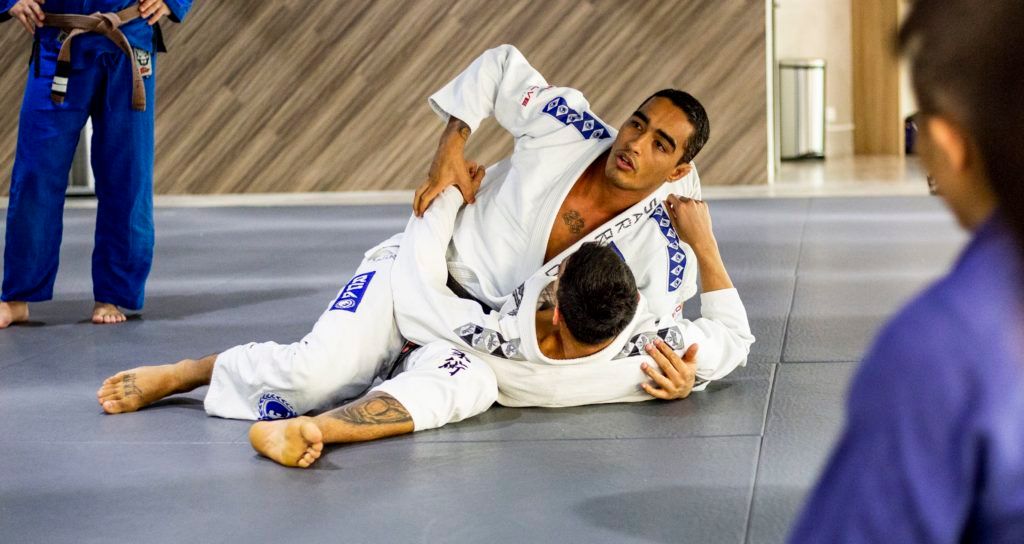
What’s the point of Brazilian Jiu-Jitsu? You’ll probably get as many different answers to this question, as there are people training in the Gentle Art. However, most of the responses you’ll hear will have something to do with either control, submission or both. The interesting part about it is that there’s no right or wrong answer – everyone has different goals when they roll. Still, for anything to be possible in BJJ, there has to be some amount of control. Now, control, in a grappling sense, is a tricky thing, and we’ll get into it more a bit later. Equating control to pinning someone is usually what most people consider to be controlling and opponent. In that sense, BJJ pins are a very important aspect of Jiu-Jitsu. They are, however, a far cry from wrestling pins, and this is exactly the distinction we’ll be focusing on today.
In almost any grappling martial art, a pin is considered getting someone’s shoulder blades to the floor and holding them there for an allocated period of time. When it comes to wrestling, Judo, Sambo to an extent, etc., this is the ultimate thing to look for, as it will immediately win you a match. In sports like Brazilian Jiu-Jitsu and MMA, though, pinning someone, as effective as it may be, won’t win you a fight. In fact, most often, it’ll barely get you points. And yet, we often talk about BJJ pins and how to hold people down. The important thing to know is that BJJ pins and wrestling pins have several crucial differences. While we tend to use the same term as in wrestling, pinning in BJJ doesn’t just mean holding an opponent down.
The Hardest Thing In Grappling
It is not easy to control a person’s movements, particularly in a grappling sense, against their will. That is why BJJ is so much fun to train. If you take a careful look at the sport, though, you’ll notice that the goals people often quote as primary have one thing in common – they’re notoriously difficult to achieve. Those goals are control and submissions. We’ve explored the subject of BJJ submissions in-depth previously, so control is going to be in the crosshairs today.

As such, control in BJJ is very tricky. The goal is to restrict someone from moving, while still being able to move in a very particular fashion yourself. Moreover, you want to be guiding your opponent into moving towards a direction you want, all the while making it seem like it is their own choice. The ultimate feat of trickery. In that sense, it is best if you think about control in BJJ, and BJJ pins in general, as methods of restricting movement and directing it in a direction you choose. Often times, you might hear the term “dynamic control” in a Jiu-Jitsu class. That is exactly what this means – focusing on restricting specific movements so that only a few options remain. Moreover, during that time, you want to be able to move and set up finishing moves, rather than use your entire body to hold a person in place.
Wrestling Pins: Why We Still Need Them
With regard to all of the above, wrestling pins still do have a place in BJJ. They’re just not the optimal way to win a BJJ match. A good example would be passing the guard. Whenever you manage to pass a guard, in most cases, you’ll find yourself in side control. That’s three points in a BJJ match, but only if you manage to stay in side control for at least three seconds. Knowing how to use a wrestling pin to maintain your position is going to earn you points, make your opponent struggle to get out, and give you quite the amount of control over the action.
But what happens next? It will be obvious to all the seasoned competitors, but it is still worth mentioning that side control, as a position, does not earn you points. The guard pass is what earns three points, and side control is just the first immediately available top position after that. Staying in side control in BJJ, and pinning someone down from there for longer than a minute will get you a warning from a referee, and ultimately, even negative points. In fact, pass a guard in the first minute of the match, and before five minutes are up if you’re doing nothing but holding side control, you’ll get a DQ after several warnings and negative points.
That said while wresting pins are not really practical as BJJ pins, they are by all means necessary and important to know. In my academy, we drill them regularly, mostly as games in which you need to do a picture-perfect wrestling pin – get someone’s shoulder to the ground and hold them there for the count of 5. They do come in handy as such, and are a must, especially for people just starting Jiu-Jitsu. However, at a certain point, you’ll have to “evolve” toward BJJ pins, if you want to have an effective Jiu-Jitsu game.
What Makes BJJ Pins Different
BJJ pins are different mostly in the sense that they’re not pins per se. Grappling martial arts have led us to categorize pins as moves that help us press and hold someone down, preventing them from moving certain body parts. BJJ pins, on the other hand, focus on restricting people’s movements, but not taking them away completely. Let me elaborate.

In Twister side control, that means blocking the head and shoulders from moving. This leaves the legs and hips mobile and does not pin both shoulder blades to the ground. It does, however, allow you to move into the mount, submit directly, or use the directions in which the opponent can move to actually improve your position.
The goal with BJJ pins is to prevent people from positioning themselves in a situation where they can escape. An escape, though, means both the current position and the one that would come next. In other words, you need to be thinking ahead and having different options ready. If you understand pinning in BJJ, this will become easy. Moreover, scrambles are going to become much more predictable, as you spend more time rolling and discover the patterns of movement people usually use. So, dynamic control in Jiu-Jitsu means pinning someone, by not letting them move in a very specific direction and/or manner while leaving yourself at least two different options for progressing through the positional and technical BJJ hierarchy.
Conclusion
BJJ pins are still pins, and the goal is still to have people stay in a certain spot. The difference from a wrestling pin is that you don’t have to immobilize the person to do it. It is enough to restrict them from going in one, or a few very specific directions .that is much easier to achieve than trying to hold someone down, particularly when there is a notable size difference. While the traditional wrestling pin still has a role to play, it is best to combine it with the dynamic nature of BJJ pins in order to develop a crushing top game that will have you transition like a panther at the same time.


![Darce Choke Encyclopedia – Origins, Mechanics and Variations [2024] BJJ, choke, Brabo, BJJ Darce Choke, D'arce Choke, Darce BJJ Choke](https://bjj-world.com/wp-content/uploads/2017/11/JungPoirierLeeYahoo-218x150.jpg)









![Leg Lock Strategies: Navigating Entanglements Jack Stapleton DVD Review [2024] Leg Lock Strategies: Navigating Entanglements Jack Stapleton DVD Review](https://bjj-world.com/wp-content/uploads/2024/12/navigating-entanglements-jack-stapleton-dvd-review-218x150.png)
![Leg Locks From Beginner To Advanced Dan Manasoiu DVD Review [2024] Leg Locks From Beginner To Advanced Dan Manasoiu DVD Review](https://bjj-world.com/wp-content/uploads/2024/12/leg-locks-from-beginner-to-advanced-dan-manasoiu-dvd-review-218x150.png)
![No-Gi Open Guard K-Guard Lachlan Giles DVD Review [2024] No-Gi Open Guard K-Guard Lachlan Giles DVD Review](https://bjj-world.com/wp-content/uploads/2024/12/no-gi-open-guard-k-guard-lachlan-giles-dvd-review-218x150.png)

![Woj Lock the World Chris Wojcik Ankle Locks DVD Review [2024] Woj Lock the World Chris Wojcik Ankle Locks DVD Review](https://bjj-world.com/wp-content/uploads/2024/12/woj-lock-the-world-chris-wojcik-dvd-review-218x150.png)
![Assassin Choke Baret Yoshida DVD Review [2024] Assassin Choke Baret Yoshida DVD Review](https://bjj-world.com/wp-content/uploads/2024/10/assassin-choke-baret-yoshida-dvd-review-324x235.png)
![Darces From Everywhere Kade and Tye Ruotolo DVD Review [2024] Darces From Everywhere Kade and Tye Ruotolo DVD Review](https://bjj-world.com/wp-content/uploads/2024/10/darces-from-everywhere-kade-and-tye-ruotolo-dvd-cover-100x70.png)
![The Whole Omoplata Enchilada Lyanne Perez DVD Review [2024] The Whole Omoplata Enchilada Lyanne Perez DVD Review](https://bjj-world.com/wp-content/uploads/2024/11/whole-omoplata-enchilada-lyanne-perez-dvd-review-100x70.png)











![Neil Melanson DVD Bundle Review: Filthy Brutal No Good Attacks [2024] Neil Melanson DVD Bundle Review: Filthy Brutal No Good Attacks](https://bjj-world.com/wp-content/uploads/2024/10/neil-melanson-dvd-bundle-review-filthy-attacks-100x70.png)

![Osoto Gari for Jiu Jitsu Jackson Nagai DVD Review [2024] Osoto Gari for Jiu Jitsu Jackson Nagai DVD Review](https://bjj-world.com/wp-content/uploads/2024/10/osoto-gari-for-jiu-jitsu-jackson-nagai-dvd-review-100x70.png)
![Jett Thompson Master Ankle and Aoki Lock DVD Review [2024] Jett Thompson Master Ankle and Aoki Lock DVD Review](https://bjj-world.com/wp-content/uploads/2024/09/jett-thompson-master-ankle-and-aoki-lock-dvd-review-100x70.png)
![No-Gi Pressure Mastery JT Torres DVD Review [2024] No-Gi Pressure Mastery JT Torres DVD Review](https://bjj-world.com/wp-content/uploads/2024/10/no-gi-pressure-mastery-jt-torres-dvd-review-100x70.png)









